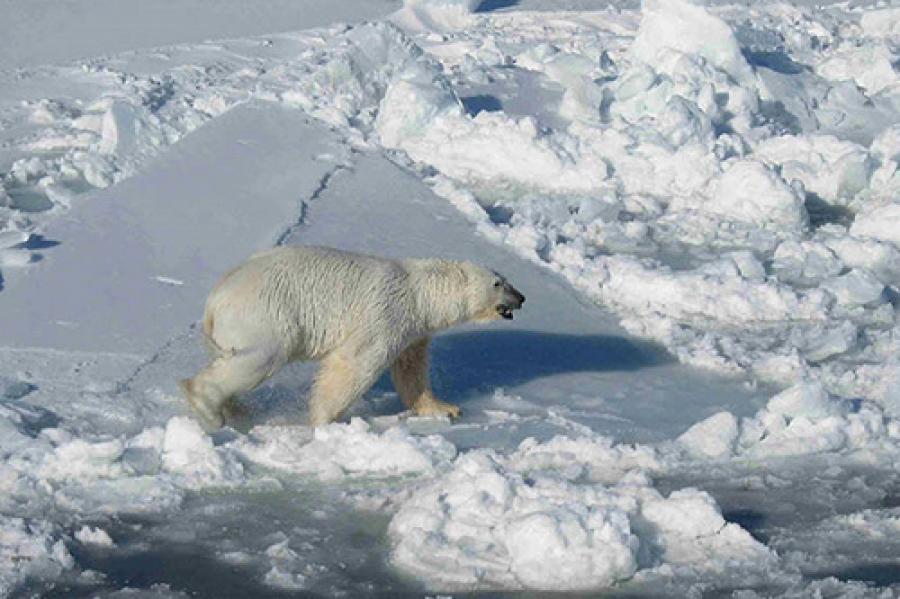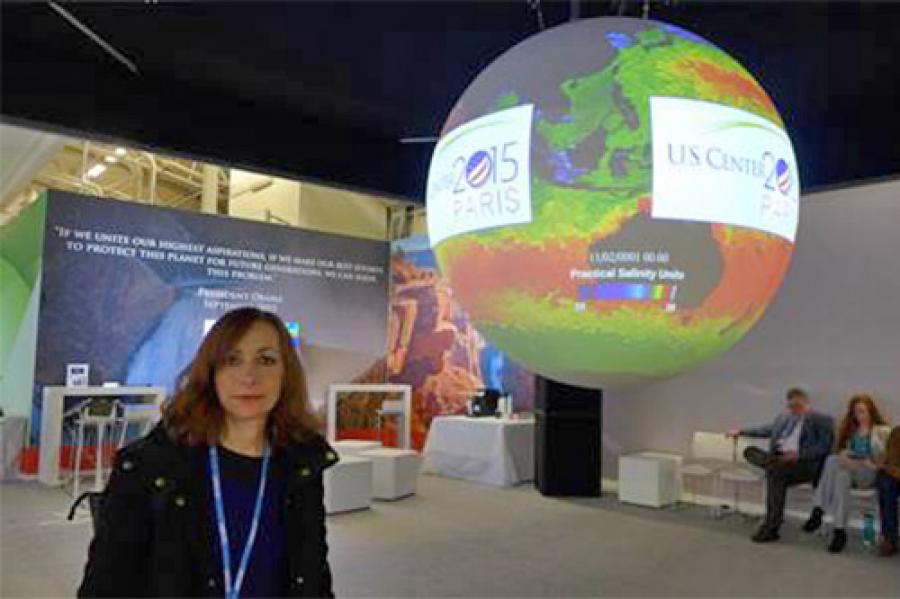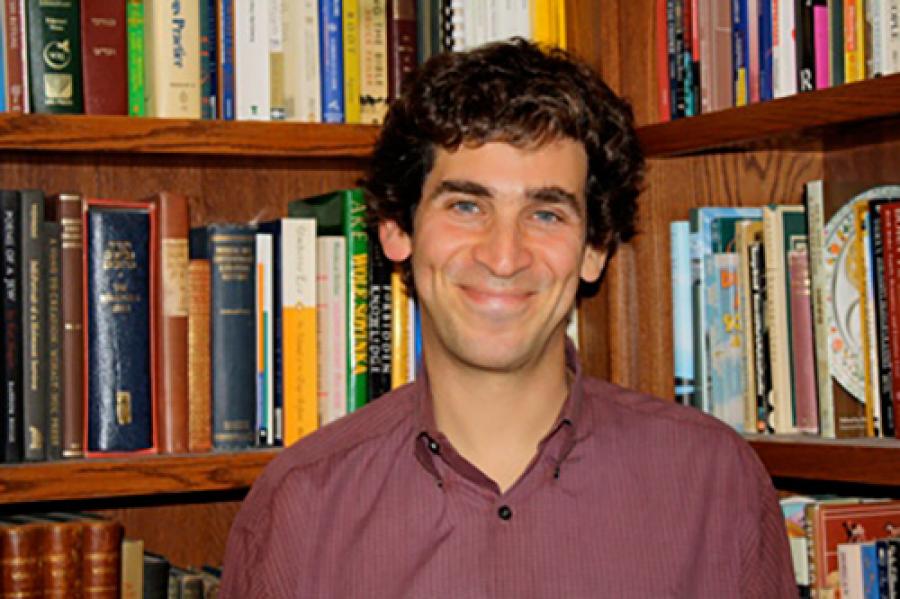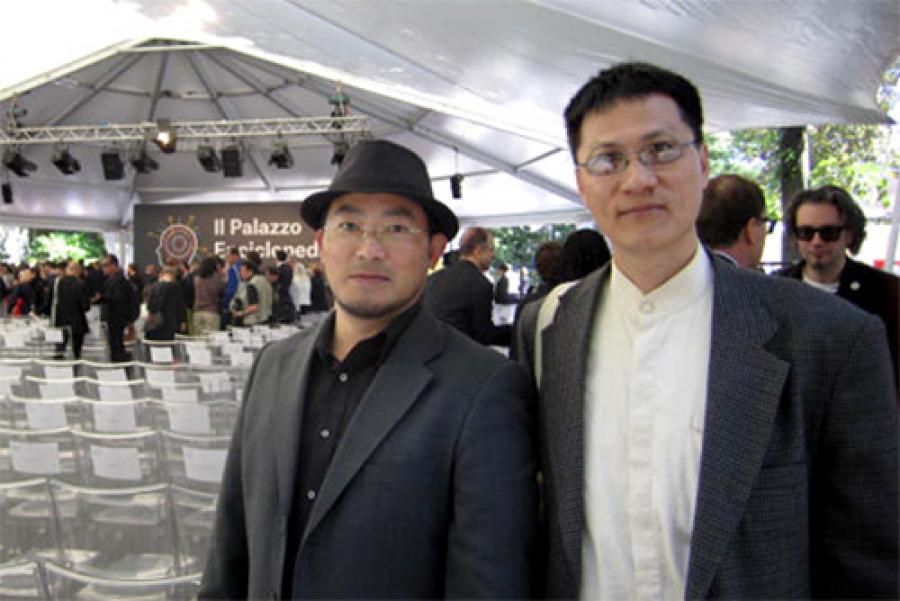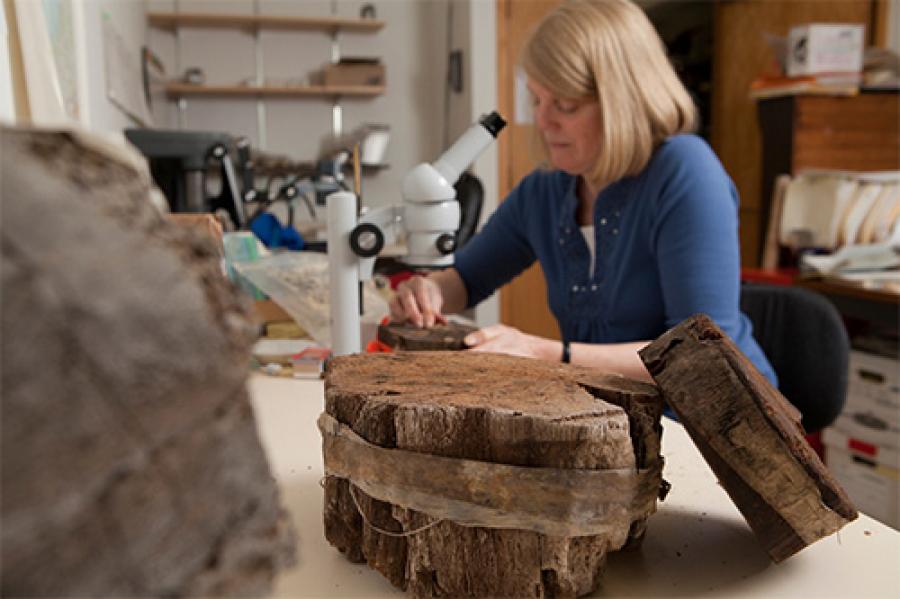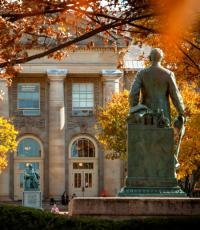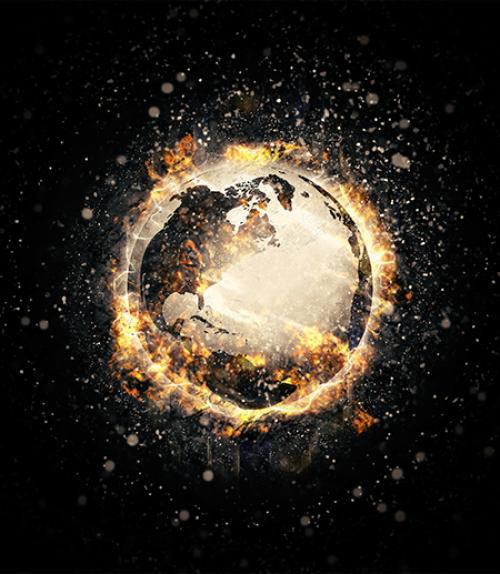The ice stretches as far as the eye can see, but it is rotten: nowhere can the polar bear find safe footing. It lifts its massive head, desperately scrambling for purchase as the ice crumbles beneath its massive paws. – Polar Bear PSA
We are all at risk from climate change and other 21st century environmental dangers, and technology alone does not hold the answers. Humanists at Cornell offer a critical perspective in the search for solutions.
“Climate change is so vast that it involves time, how we live, it encompasses inequality – it’s so much more global than any specific environmental problem,” says Romance studies and comparative literature professor Karen Pinkus, one of four Cornell professors selected to attend the December 2015 Paris COP21 climate change negotiations.
“While big data studies and computer modeling can tell us something quantitatively, they don’t really give us a sense of what we might be facing as humans,” says Pinkus. “A historical perspective informed by critical theory gives us the perspective to begin to think creatively about the future.”
Professor Karen Pinkus at COP21
As Director of the Atkinson Center for a Sustainable Future Francis DiSalvo notes, sustainability is encompassed by three interdependent and interconnected objectives: reliable energy, resilient environment and responsible economic development. In the case of climate change, exploring solutions at the nexus of all three of these is critical. “Technological solutions, while necessary, are not sufficient. The cultural, social, historical, political and behavioral aspects of being human will determine what, how and if we will create a sustainable path for our planet and species,” says DiSalvo, John A. Newman Professor of Physical Science, Department of Chemistry and Chemical Biology.
Telling a story, learning from the past
In 2025, car companies, energy companies, and hydrogen industry suppliers manage to convince several countries to build hydrogen infrastructure…policymakers recognize the pressing need to secure stable and affordable electricity supplies and to reduce emissions from urban transport. A flexible, efficient, and clean energy system is born. - based on a Shell oil company scenario
Without the right stories being told, producing good science isn’t enough to make an impact. People need to be able to imagine themselves living in that story and that future, as Anindita Banerjee, associate professor of comparative literature, points out. How people identify with a story can have a great impact on the future of political action, policy and even research and development.
“The energy industry got the importance of telling stories a lot earlier than the environmental movement,” Banerjee adds. “‘Scenarios’ are a very active part of how energy corporations have been managing their presence in public life.”
While energy companies invest in corporate approaches to imagining the future, Pinkus says of humanists that “we’re not tied down by having to prove that our versions of the future are based on previous models, which gives us the freedom. This is really important as what are facing calls for something far beyond the reforms of even the most conscientious democratic institutions.”
For example, Pinkus suggests thinking about the future and climate change through the double lens of Homer’s Odyssey, and critical theory. “The Odyssey is an incredibly rich text with so many different forms of language, different ways of conceiving time and human’s relationship to time and history, and so many different ways of telling a story,” she explains. “In its complexity, it seems more adapted to the very complex situation we’re facing now with climate change than, say, a scientific study trying to predict concentrations of greenhouse gases in the atmosphere. It teaches us that we don’t have an easy control over the future.” More so, she argues, than the new genre of "cli-fi," which tends to repeat familiar tropes even if they are frightening.
Environmental historian Aaron Sachs, associate professor of history, says that as we struggle with the overwhelming nature of 21st-century problems, it’s important to remember the power of retrospection. “While no one can predict the future, the past offers lessons, not just from its calamities but from previous good ideas – like incorporating green space into our everyday habitations.”
As Sturt Manning points out, the earth’s climate changes constantly and has through history. The classical world and the greater old world offer an extraordinary rich history over several thousand years and a detailed archaeological record back ever further, says Manning, the Goldwin Smith Professor of Classical Archaeology and chair of classics, who teaches Climate, Archaeology and History. That class brings together students from humanities and sciences, engaging them in a common -- and critical -- dialogue.
“By studying in detail the relationships between human societies and climate over time, we can begin to understand the impact climate change can have and we can see how humans succeeded or failed to adapt. Climate and classics are good partners and relevant ones for the current and future world.”
Manning has published numerous studies, some sparked by joint humanities-sciences groups, addressing how climate history can be brought into discussion with human history. He recently spoke on “Climate Change and Human Society: Beyond Crisis to Opportunity and History” at the Presidential Plenary Session of the Archaeological Institute of America at its Annual Meeting in San Francisco.
Studying the causes of environmental injustice
COP21, Paris, 2015: Thousands of protestors hold hands beneath the looming Eiffel Tower. Their red banner stretches more than a mile, representing the “red line” they say COP21 negotiators must not cross if the vulnerable are to be protected from climate change.
“A big focus in environmental studies is environmental justice – exposing environmental injustice that’s built into our system of resource use,” says Sachs, highlighting the plight of people in particularly vulnerable communities who tend to get “dumped on” in environmental terms. “If there weren’t vulnerable communities to put our toxic waste in, maybe we would find a way to not make as much toxic waste.”
Associate professor Aaron Sachs
Sachs is working on two projects: a history of environmental justice and an examination of why our culture ignores obvious environmental problems.
“We’re benefitting from the modern complex of energy development, but also suffering from it,” he explains. “We’ve had the technology and techniques for several decades to deal with climate change and we have not had the political and cultural will to actually do anything about it. Why have we bought into this culture so deeply despite these aspects that make most of us really uncomfortable?”
“Climate is a threat multiplier,” agrees Maria Cristina Garcia, the Howard A. Newman Professor of American Studies, who’s writing a book on climate refugees. “Many of the political upheavals of the last 40 years have an environmental component that contributed to dislocation. It has a cascading effect. We need to figure out how to respond to populations that are most at risk as a result of climate change.”
Art can offer crucial perspectives and even interventions related to environment justice, as An-yi Pan, associate professor of history of art and visual studies, demonstrated in the exhibit he curated at the 2013 Venice Biennale (a major contemporary art exhibition in Italy). With the goal of raising awareness about the effects of climate change, his exhibit focused on the Polynesian island nation of Tuvalo, which is expected to be the first victim of a rising ocean level caused by global warming.
Associate professor An-yi Pan (right) with artist Vincent J.F. Huang
Pan notes that artists throughout history have used their work to express their concerns about social and environmental problems. “Even during the Tang Dynasty, artists used their work to explore ways to find harmony between the self and the environment,” he says.
Classes consider climate change
Replanting native species in forest and on dry land reserves in Hawai’i…working with indigenous people…considering ancient Hawaiian indigenous food provisioning systems and food self-sufficiency on the islands today. – Activities by Victoria Nadile ’15, during a Sustainability Semester course
Cornell has a university-wide climate change minor, thanks to a team that included Pinkus and faculty from three colleges and five departments. (Establishing aa university-wide environment and sustainability major is currently being explored.) Some of the minor’s required core courses examine the human relationship to climate change, such as Ethics & the Environment, taught by historian Sara Pritchard, associate professor of science & technology studies. The class explores some of the challenging moral issues that arise in the context of environmental management and policy-making.
“The course encouraged me to think critically about high-stakes issues, which sometimes do not always yield a neat answer, if any answer at all,” Nadile says.
Associate professor Sara Pritchard
Before coming to Cornell, Nadile says she didn’t realize how many people live in and depend on fragile ecosystems. “I have realized that various resources—which have made my life very comfortable—are not available to everyone, and those of us who live in the developed parts of the world are in danger of over-relying on those resources. The experiences I was fortunate to have at Cornell have made me acutely aware that we have to come up with a better rate of return for our planet, and we need to make this more of a priority.”
Collaboration and conversation
Complex environmental issues can best be understood by considering diverse perspectives, Sachs says – including those of the humanities, arts, social sciences, natural sciences, physical sciences and other sciences. He founded the Cornell Roundtable on Environmental Studies Topics (CREST), which has members from 20 departments on campus, to foster communication and collaboration across disciplines.
CREST events this spring include a screening and discussion of the short film "Fragile Legacy,” produced by David Brown ’83.
Pinkus, one of 19 College humanists who are Atkinson Faculty Fellows, recently held a topical lunch at the Atkinson Center for a Sustainable Future (ACSF) to which she invited scientists, engineers and humanists. The topic was geoengineering, Pinkus’ particular interest. She’s working on a paper about the subsurface, in which she uses visual art and texts to examine its relation to humans and human time.
In Pinkus’ new book, “Fuel,” she argues for the separation of fuel (potential) from energy (power), engaging with literature, art and critical theory to think beyond fossil fuels to the bigger picture.
Banerjee’s fall Atkinson Center fellowship enabled her to engage in conversations with engineers, social scientists and business experts about her work, and led to a symposium she’s organizing for Feb. 26. “Oil and the Human: Views from the East and South” will consider the role of oil in everyday life in Africa, East Asia, Russia and Latin America.
“Oil shapes human life and impacts human values across the planet in profoundly connected ways. Yet rarely do we think of oil beyond the boundaries of nation-states and geopolitical regions,” Banerjee says.
Banerjee’s upcoming book, “Fuel Fictions, Energy, Art and Power in Modern Russia,” explores the complex relationship between energy and art in Russia today. “Far from just reproducing the visions of the state and the industry, Russian writers, artists, and performers have co-opted various forms of energy to create new aesthetics and politics of resistance,” she says. “Nuclear power stations, dams, oil pipelines are things that seem mundane, but they can be made into active instruments of artistic protest and public consciousness building.”
An example of such resistance mentioned in the book is punk group Pussy Riot’s intervention against Rosneft, a Russian oil company. The activists sought to encourage oil pipeline workers to organize for better conditions; Pussy Riot’s video, “Like a Red Prison,” went viral.
Hands-on Research
This past summer, researchers at the Cornell Tree-Ring Laboratory dug up trees that grew 12,000 years ago only a few hours' drive from Cornell. They represent a period of extreme climate change at the end of the last glacial period. The researchers are able to extract data from the wood about changing temperatures and precipitation patterns, using both tree-ring growth patterns plus stable isotope analysis. (The project receives support from the National Geographic Society Committee for Research and Exploration.)
Carol Griggs '77, Ph.D. '06 in the Dendrochronology Lab
“Part of our focus is to see what the climate conditions were, and how they changed at that time. This will help assess whether the extreme recent changes are unique or happened before – and what happens when these changes do occur,” explains Carol Griggs '77, Ph.D. '06, senior classics research associate and manager of the dendrochronology lab. “It’s well known that there was extreme climate change back then, but very little is known about regional-scale changes in this (our own) area. We’re working on determining what and when changes occurred, and whether they were affected by the melting of the nearby ice sheet or other ongoing processes.”
This feature is part of the New Century for the Humanities "Big Ideas" project to explore broad contemporary themes in the humanities. The New Century for the Humanities is a series of events and projects initiated to celebrate the opening of Klarman Hall, the first building dedicated to the humanities on Cornell's central campus in more than 100 years.

